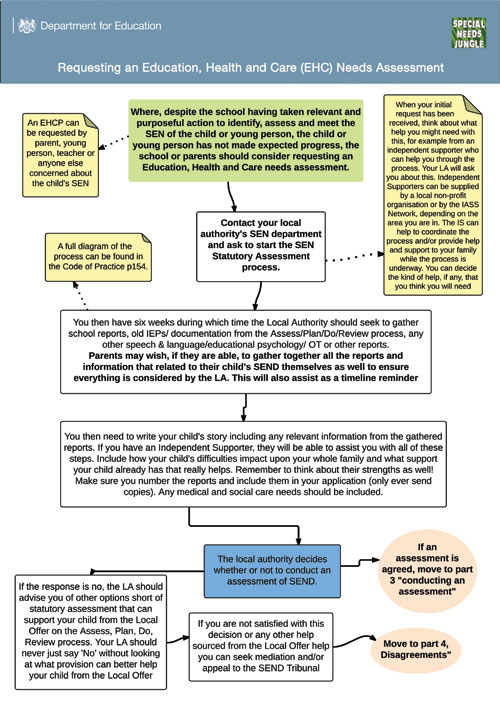STEP ONE: IDENTIFYING
We found that the identification step of an EHCP journey includes what happens from the point at which it is known or suspected that a child or young person has Special Educational Needs and Disability (SEND) to the Local Authority deciding whether or not to conduct an assessment.
WHAT DID PARENTS TELL US ABOUT IDENTIFYING?
What this step involves
Our research shows this step often involves:
- Referral by a professional (GP, Health visitor, nursery, school or college for example); Self-referral, where a parent or carer makes a request; Transferring from a Statement of Special Educational Needs or a Learning Difficulty Assessment (LDA)
- Completion of an application form (online or paper)
- Evidence submitted from a range of professionals (e.g. school reports, IEPs, speech and language therapist reports, Occupational therapy reports etc)
- Evidence submitted by families
- Evidence to demonstrate that the school has taken relevant action to meet the needs of the child or young person but that the child or young person has not made expected progress
- Possibly a member of the SEN team meeting with the family to discuss their child’s needs and the EHCP process
What the code of practice says
Click here to read the document online
9.8
The following people have a specific right to ask a local authority to conduct an education, health and care needs assessment for a child or young person aged between 0 and 25:
- the child’s parent
- a young person over the age of 16 but under the age of 25, and
- a person acting on behalf of a school or post-16 institution (this should ideally be with the knowledge and agreement of the parent or young person where possible)
9.9
In addition, anyone else can bring a child or young person who has (or may have) SEN to the attention of the local authority, particularly where they think an EHC needs assessment may be necessary.
9.11
the local authority must determine whether an EHC needs assessment is necessary. The local authority must make a decision and communicate the decision to the child’s parent or to the young person within 6 weeks of receiving the request.
9.12
In considering whether an EHC needs assessment is necessary, local authorities must have regard to the views, wishes and feelings of the child and his or her parent, or the young person. At an early stage, the local authority should establish how the child and his or her parent or the young person can best be kept informed and supported to participate as fully as possible in decision-making. The local authority must arrange for the child and his or her parent or the young person to be provided with advice and information relevant to the child or young person’s SEN
Parents want …
Early intervention and identification
- They value their child’s needs being identified early and appropriate action being taken.
- They want professionals to listen to their concerns about their child’s progress or issues at school
- They are less satisfied when identification happens at a point of crisis – when children are falling behind with learning, not getting on at school, being excluded or the family are finding it hard to cope
Clear information
- Information provided can be unclear, hard to find and difficult to understand. For some, there is not enough information given about what the EHCP process involves
- There is limited knowledge amongst some schools and colleges about the process
- Roles and responsibilities for the EHC process are not always clear
They value:
- having someone to talk them through the process;
- clear and concise written information;
- parent events to tell them about the process.
Clarity on the application process for an assessment
- They are unsure what evidence is needed to make the case for an assessment.
- They feel application forms don’t capture sufficient detail.
They value:
- support to empower them to contribute to the application for assessment
- a home visit to go through the evidence in the referral/assessment form
- someone to talk to about their child, their schooling and 3s rolex datejust 116203csj mens rolex calibre 2836 2813 champagne dial the family context
Clear signposting
- It is not clear who to contact at the local authority for help. Families may be concerned about their child but do not associate this with a potential special educational need or disability (SEND). This makes it harder for them to know where to start looking for help.
- Self-referral needs to be an easy to find and transparent process
- They find it confusing to understand who can apply for an EHC needs assessment and when it might be appropriate.
Independent advice and support
- They have little knowledge of how the system and process works, what happens and what they need to do.
- They are looking for advice and support as often they find it a stressful experience.
- They often want someone independent to talk to about their experience.
- Many turn to national organisations specific to their child’s needs for advice
The transfer process from statements or LDAs to EHCPs to be clear
- They have concerns that they need to reapply for an EHCP or restart the process to transfer.
- The timing of transfers is not clear and they are unsure what to do if the child or young person is changing placement.
- There is uncertainty about which young people need an EHC plan and to inform services of the continuing needs of young people post-16
Read family stories …
PRACTITIONER CHECKLIST
Practical Steps to Help Parents Through the Identifying Step
CHECK YOUR IDENTIFYING PROCESS
Good Practice
Service 3 employ a Parent Engagement Officer in their SEND team. His role is to meet with families from when they first make an application for an EHCP, to assess their needs and talk them through the process.
As soon as an application is received, either from a school, another professional or a parent Aaron arranges to meet the family either at home or at school. He talks through the evidence submitted in the application to understand the child’s needs, the families’ circumstances and their reason for wanting an EHCP plan.
He explains all about the process and how it works in the local area. He explains about the Local Offer and the local support that exists for families including the Information, Advice and Support service and Independent Supporters.
Some families decide not to continue with their EHCP application after they have met with him (maybe because they feel there is other support available that they can try first). For the others he takes back any extra information he has picked up about the child and feeds it into the application process and decision on whether to carry out a full assessment of the child.
Service 1 has set up an online ‘wiki’ which contains all of the information families and professionals might need about the EHCP process. They have made it accessible by breaking down the information into small chunks and making it very visual and appealing to read. It all links through to greater detail if the reader decides they need it.
Its identification section includes guidance about
- making referrals and how that process works locally,
- agendas for set up meetings,
- eligibility criteria and an application form,
- details of how panels make decisions to assess,
- timings of the process and outcomes of each stage,
- support options (their role and contact details) and
- what to do if you don’t agree with a decision.
More detail is then provided on each of the further steps in the process.
Service 2 runs a monthly parents event for all those parents who are about to or have just made an application to the local EHCP process. The event is co-organised by the SEN team and the local IAS (previously the parent partnership).
Several parents are invited to attend the event which is usually held in a school in the borough. Teachers from the children’s schools, nurseries of colleges along with staff from local specialist provision, SENCOs, the SEN team and representatives from the LA (such as Head of Children’s services) all attend.
They give brief presentations about the process, what support is available, what it can help with and the types of decisions that might need to be made about schooling. Parents are then invited to ask any questions they have.
It provides an opportunity for parents to meet some of the professionals they are likely to be working with, get a sense of peoples’ roles and show that the services all work closely together.
“It’s a first chance for us to get to know each other and I think it does start to build positive relationships between us all. It shows the parents that we’re here, we’re approachable and open to being asked anything. We want to work with them collaboratively” (Head of Children’s Service)



